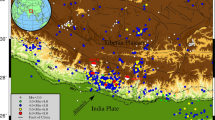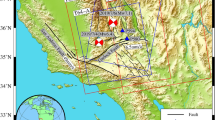Abstract
To better understand the mechanism of the Mw6.3 L’Aquila (Central Italy) earthquake occurred in 2009, global positioning system (GPS) and interferometric synthetic aperture radar (InSAR) data were used to derive the coseismic slip distribution of the earthquake fault. Firstly, based on the homogeneous elastic half-space model, the fault geometric parameters were solved by the genetic algorithm. The best fitting model shows that the fault is a 13.7 km×14.1 km rectangular fault, in 139.3° strike direction and 50.2° southwest-dipping. Secondly, fixing the optimal fault geometric parameters, the fault plane was extended and discretized into 16×16 patches, each with a size of 1 km×1 km, and the non-uniform slip distribution of the fault was inverted by the steepest descent method with an appropriate smoothing ratio based on the layered crustal structure model. The preferred solution shows that the fault is mainly a normal fault with slight right-lateral strike slip, the maximum slip of 1.01 m is located in the depth of 8.28 km, the average rake is −100.9°, and the total geodetic moment is about 3.34×1018 N·m (Mw 6.28). The results are much closer than previous studies in comparison with the seismological estimation. These demonstrate that the coseismic fault slip distribution of the L’Aquila earthquake inverted by the crustal model considering layered characters is reliable.
Similar content being viewed by others
References
ANZIDEI M, BOSCHI E, CANNELLI V, DEVOTI R, ESPOSITO A, GALVANI A, MELINI D, PIETRANTONIO G, RIGUZZI F, SEPE V, SERPELLONI E. Coseismic deformation of the destructive April 6, 2009 L’Aquila earthquake (central Italy) from GPS data [J]. Geophysical Research Letters, 2009, 36: L17307.
Istituto Nazionale di Geofisica e Vulcanologia (INGV). Measurement and modeling of co-seismic deformation during the L’Aquila earthquake, preliminary results [R]. Rome: National Earthquake Center of Italy, 2009.
ATZORI S, HUNSTAD I, CHINI M, SALVI S, TOLOMEI C, BIGNAMI C, STRAMONDO S, TRASATII E, ANTONIOLI A, BOSCHI E. Finite fault inversion of DInSAR coseismic displacement of the 2009 L’Aquila earthquake (central Italy) [J]. Geophysical Research Letters, 2009, 36: L1530
LI Li, CHEN Yong. Light of earthquake prediction: Shocks before the L’Aquila earthquake of April 6, 2009 [J]. Earthquake Research in China, 2009, 25(2): 151–158. (in Chinese)
Istituto Nazionale di Geofisica e Vulcanologia (INGV). The L’Aquila seismic sequence-April 2009 [R]. Rome: National Earthquake Center of Italy, 2009.
Emergeo Working Group. Geological surveys of the 6 April 2009 L’Aquila seismic sequence epicenter area [R]. INGV report. Ist Rome: National Earthquake Center of Italy, 2009. (in Italian)
PINO N A, LUCCIO F D. Source complexity of the 6 April 2009 L’Aquila (central Italy) earthquake and its strongest aftershock revealed by elementary seismological analysis [J]. Geophysical Research Letters, 2009, 36: L23305.
PAPANIKOLAOU I D, FOUMELIS M, PARCHARIDIS I, LEKKAS E L, FOUNTOULIS I G. Deformation pattern of the 6 and 7 April 2009, MW=6.3 and MW=5.6 earthquakes in L’Aquila (Central Italy) revealed by ground and space based observations [J]. Natural Hazards and Earth System Sciences, 2010, 10: 73–78.
GABRIEL A K, GOLDSTEIN R M, ZEBKER H A. Mapping small elevation changes over large areas: Differential radar interferometry [J]. Journal of Geophysical Research B, 1989, 94(7): 9183–9191.
MASSONNET D, ROSSI M, CARMONA C, ADRAGNA F, PELTZER G, FEIGL K, RABAUTE T. The displacement field of the Landers earthquake mapped by radar interferometry [J]. Nature, 1993, 364: 138–142.
LIU Guo-xiang, DING Xiao-li, LI Zhi-lin, LI Zhi-wei, CHEN Yong-qi, YU Shu-beih. Pre- and co-seismic ground deformations of the 1999 Chi-Chi, Taiwan earthquake, measured with SAR interferometry [J]. Computers & Geosciences, 2004, 30: 333–343.
FUNNING G J, PARSONS B, WRIGHT T J, JACKSON J A, FIELDING E J. Surface displacements and source parameters of the 2003 Bam (Iran) earthquake from Envisat advanced synthetic aperture radar imagery [J]. Journal of Geophysical Research, 2005, 110: B09406.
TONG Xiao-peng, SANDWELL D T, FIALKO Y. Coseismic slip model of the 2008 Wenchuan earthquake derived from joint inversion of interferometric synthetic aperture radar, GPS, and field data [J]. Journal of Geophysics Research, 2010, 115(B04314): 1–19.
ZHANG Hong, WANG Chao, LIU Zhi. The differential radar interferometry technique to achieve coseismic displacement field of the Zhangbei earthquake [J]. Journal of Image and Graphics, 2000, 5(6): 497–500. (in Chinese)
OKADA Y. Surface deformation due to shear and tensile faults in a half-space [J]. Bulletin of the Seismological Society of America, 1985, 75(4): 1135–1154.
TAN Hong-bo, SHEN Chong-yang, XUAN Shong-bai. Influence of crust layering and tickness on coseismic effects of Wenchuan earthquake [J]. Journal of Geodesy and Geodynamics, 2010, 30(4): 29–35. (in Chinese)
XU Cai-jun, LIU Yang, WEN Yang-mao, WANG Rong-jiang. Coseismic slip distribution of the 2008 Mw 7.9 Wenchuan earthquake from joint inversion of GPS and InSAR data [J]. Bulletin of the Seismological Society of America, 2010, 100(5B): 2736–2749.
WANG Rong-jiang. A simple orthonormalization method for stable and efficient computation of Green’s functions [J]. Bulletin of the Seismological Society of America, 1999, 89(3): 733–741.
WANG Rong-jiang. Computation of deformation induced by earthquake in a multi-layered elastic crust-FORTRAN programs EDGRN/EDCMP [J]. Computers & Geosciences, 2003, 29: 195–207.
CHELONI D, D’AGOSTINO N, D’ANASTASIO E, AVALLONE A, MANTENUTO S, GIULIANI R, MATTONE M, CALCATERRA S, GAMBINO P, DOMINICI D, RADICIONI F, FASTELLINI G. Coseismic and initial post-seismic slip of the 2009 Mw 6.3 L’Aquila earthquake, Italy, from GPS measurements [J]. Geophysical Journal International, 2010, 181: 1539–1546.
LI Zhi-wei, DING Xiao-li, HUANG Cheng, ZHU Jian-jun, CHEN Yan-ling. Improved filtering parameter determination for the goldstein radar interferogram filter [J]. ISPRS Journal of Photogrammetry & Remote Sensing, 2008, 63: 621–634.
LI Zhi-wei, DING Xiao-li, ZHU Jian-jun, ZOU Zheng-rong. Quantitative study of atmospheric effects in spaceborne InSAR measurements [J]. Journal of Central South University of Technology, 2005, 12(4): 494–498.
JIANG Mi, DING Xiao-li, LI Zhi-wei, ZHU Jian-jun, YIN Hong-jie, WANG Yong-zhe. Study on coseismic deformation of Wenchuan earthquake by use of land C waveband of SAR data [J]. Journal of Geodesy and Geodynamics, 2009, 29(1): 21–26. (in Chinese)
JONSSON S, ZEBKER H, SEGALL P, AMELUNG F. Fault slip distribution of the 1999 Mw7.1 Hector Mine, California, earthquake, estimated from satellite Radar and GPS measurements [J]. Bulletin of the Seismological Society of America, 2002, 92(4): 1377–1389.
HANSSEN R F. Radar interferometry: Data interpretation and error analysis [M]. Dordrecht: Kluwer Academic Publishers, 2001: 162–163.
HOLLAND J H. Adaptation in the natural and artificial systems [M]. Michigan: University of Michigan Press, 1975: 1–10.
WANG Rong-jiang. PSGRN/PSCMP-A new code for calculating co- and post-seismic deformation, geoid and gravity changes based on the viscoelastic-gravitational dislocation theory [J]. Computers & Geosciences, 2006, 32: 527–541.
BONCIO P, PIZZI A, BROZZETTI F, POMPOSO G, LAVECCHIA G, NACCIO D D, FERRARINI F. Coseismic ground deformation of the 6 April 2009 L’Aquila earthquake (Central Italy, Mw6.3) [J]. Geophysical Research Letters, 2010, 37: L06308.
LIU Chao, XU Li-sheng, CHEN Yun-tai. Quick moment tensor solution of the 2009 April 6, L’Aquila, Italy earthquake [J]. Acta Seismologica Sinica, 2009, 31(4): 464–466. (in Chinese)
FENG Wan-peng, LI Zhen-hong, LI Chun-lai. Optimal source parameters of the April 2009 Mw 6.3 L’Aquila, Italy earthquake from InSAR observations [J]. Progress in Geophysics, 2010, 25(5): 1550–1559. (in Chinese)
Author information
Authors and Affiliations
Corresponding author
Additional information
Foundation item: Projects(40974006, 40774003) supported by the National Natural Science Foundation of China; Project(NCET-08-0570) supported by the Program for New Century Excellent Talents in Chinese Universities; Projects(2011JQ001, 2009QZZD004) supported by the Fundamental Research Funds for the Central Universities in China; Projects(09K005, 09K006) supported by the Key Laboratory for Precise Engineering Surveying & Hazard Monitoring of Hunan Province, China; Project(1343-74334000023) supported by the Graduate Degree Thesis Innovation Foundation of Central South University, China
Rights and permissions
About this article
Cite this article
Wang, Yz., Zhu, Jj., Ou, Zq. et al. Coseismic slip distribution of 2009 L’Aquila earthquake derived from InSAR and GPS data. J. Cent. South Univ. Technol. 19, 244–251 (2012). https://doi.org/10.1007/s11771-012-0998-1
Received:
Accepted:
Published:
Issue Date:
DOI: https://doi.org/10.1007/s11771-012-0998-1




